Biochemistry Assignment: Biomolecules, Enzyme Inhibition, and Lipids
VerifiedAdded on 2020/03/13
|12
|3202
|730
Homework Assignment
AI Summary
This biochemistry assignment solution addresses several key concepts. Part A explores the variation in boiling points of similar molecular weight compounds, the difference in melting points of fatty acids, and the antibacterial activity of amides. The assignment delves into the structural classification of carbohydrates, the levels of protein structure organization, and the role of lipids in maintaining cell membrane structure in Part B. Finally, Part C examines the mechanism and effect of cyanide-induced enzyme inhibition in cellular respiration. The solution demonstrates an understanding of intermolecular forces, biomolecule structure and function, and the impact of metabolic inhibitors.
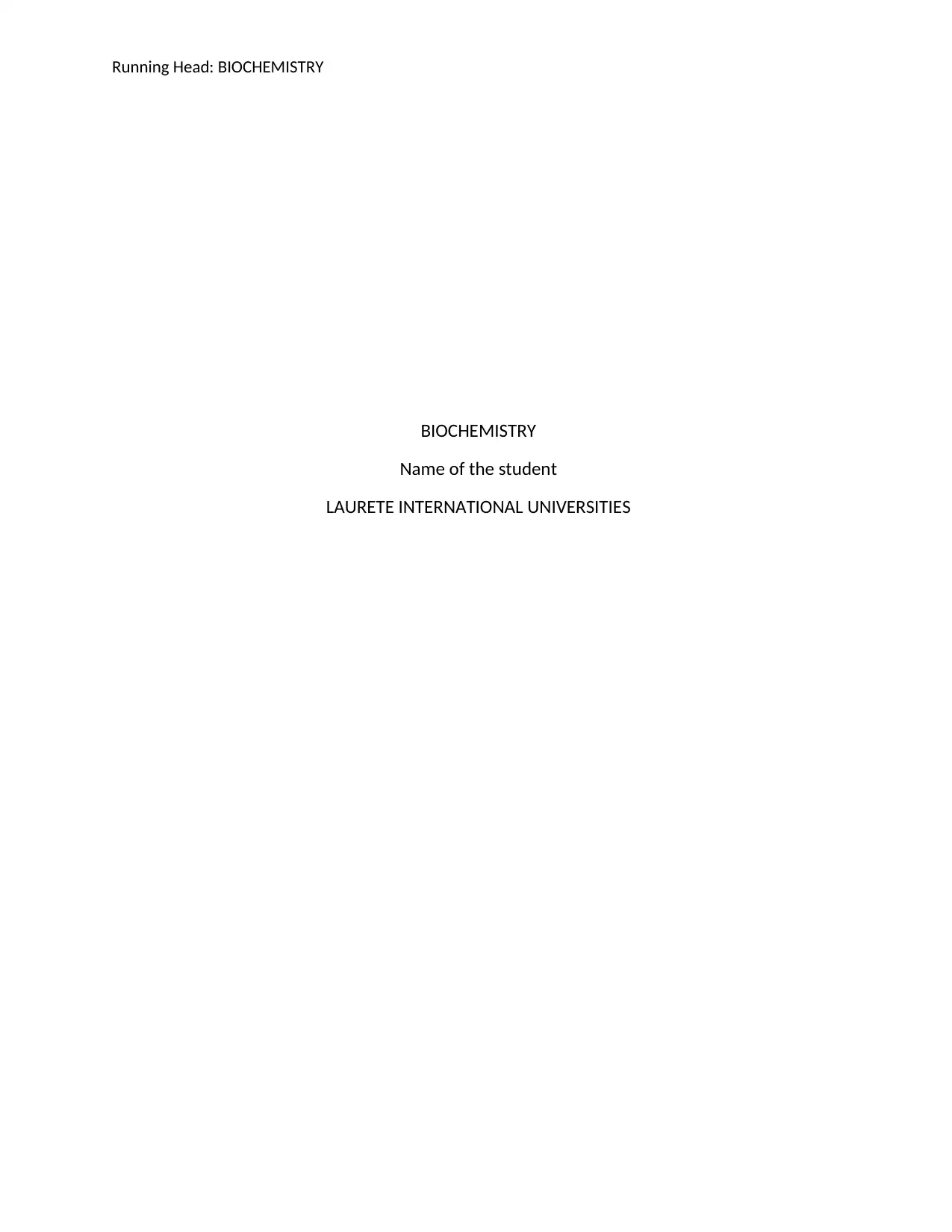
Running Head: BIOCHEMISTRY
BIOCHEMISTRY
Name of the student
LAURETE INTERNATIONAL UNIVERSITIES
BIOCHEMISTRY
Name of the student
LAURETE INTERNATIONAL UNIVERSITIES
Paraphrase This Document
Need a fresh take? Get an instant paraphrase of this document with our AI Paraphraser
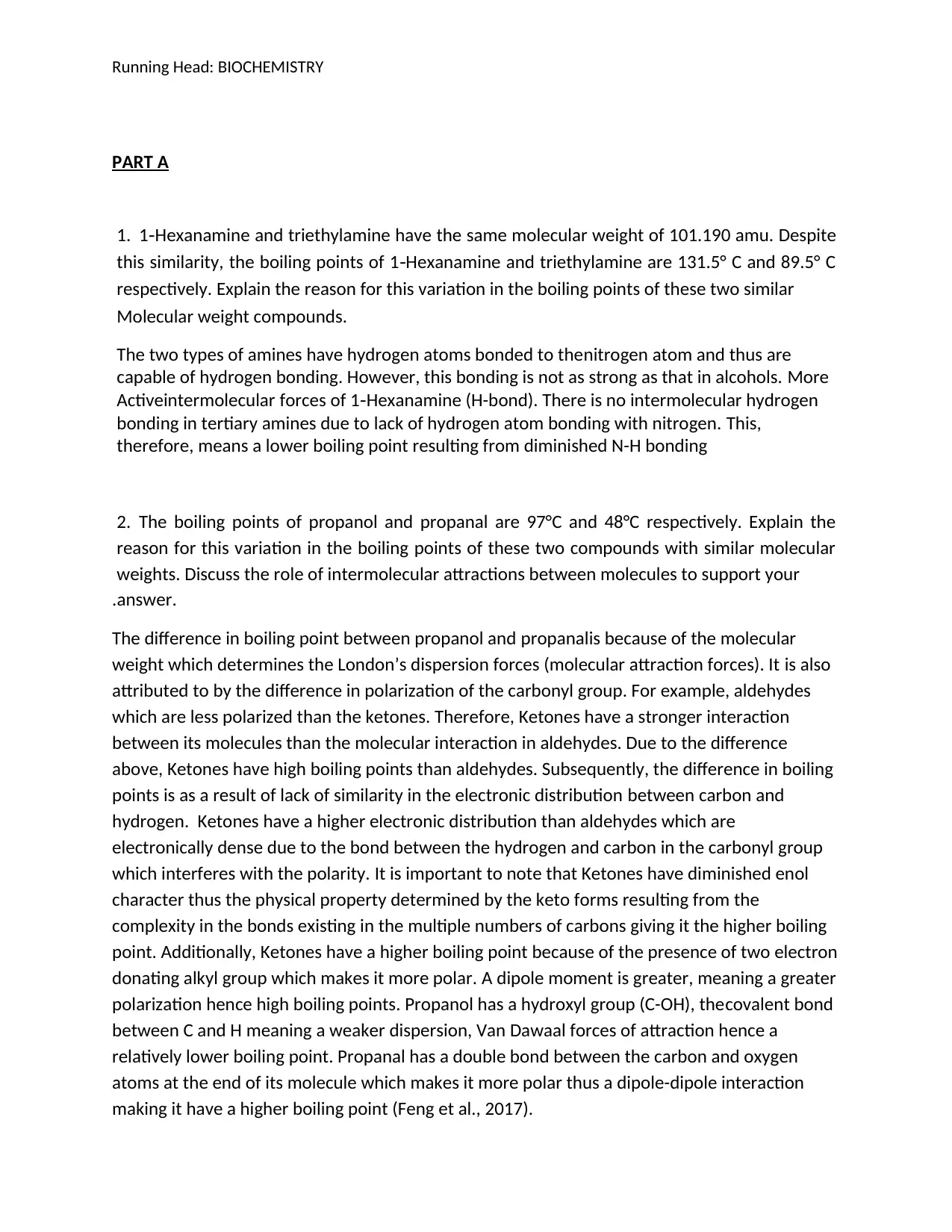
Running Head: BIOCHEMISTRY
PART A
1. 1 Hexanamine and triethylamine have the same molecular weight of 101.190 amu. Despite‐
this similarity, the boiling points of 1 Hexanamine and triethylamine are 131.5° C and 89.5° C‐
respectively. Explain the reason for this variation in the boiling points of these two similar
Molecular weight compounds.
The two types of amines have hydrogen atoms bonded to thenitrogen atom and thus are
capable of hydrogen bonding. However, this bonding is not as strong as that in alcohols. More
Activeintermolecular forces of 1‐Hexanamine (H-bond). There is no intermolecular hydrogen
bonding in tertiary amines due to lack of hydrogen atom bonding with nitrogen. This,
therefore, means a lower boiling point resulting from diminished N-H bonding
2. The boiling points of propanol and propanal are 97°C and 48°C respectively. Explain the
reason for this variation in the boiling points of these two compounds with similar molecular
weights. Discuss the role of intermolecular attractions between molecules to support your
.answer.
The difference in boiling point between propanol and propanalis because of the molecular
weight which determines the London’s dispersion forces (molecular attraction forces). It is also
attributed to by the difference in polarization of the carbonyl group. For example, aldehydes
which are less polarized than the ketones. Therefore, Ketones have a stronger interaction
between its molecules than the molecular interaction in aldehydes. Due to the difference
above, Ketones have high boiling points than aldehydes. Subsequently, the difference in boiling
points is as a result of lack of similarity in the electronic distribution between carbon and
hydrogen. Ketones have a higher electronic distribution than aldehydes which are
electronically dense due to the bond between the hydrogen and carbon in the carbonyl group
which interferes with the polarity. It is important to note that Ketones have diminished enol
character thus the physical property determined by the keto forms resulting from the
complexity in the bonds existing in the multiple numbers of carbons giving it the higher boiling
point. Additionally, Ketones have a higher boiling point because of the presence of two electron
donating alkyl group which makes it more polar. A dipole moment is greater, meaning a greater
polarization hence high boiling points. Propanol has a hydroxyl group (C-OH), thecovalent bond
between C and H meaning a weaker dispersion, Van Dawaal forces of attraction hence a
relatively lower boiling point. Propanal has a double bond between the carbon and oxygen
atoms at the end of its molecule which makes it more polar thus a dipole-dipole interaction
making it have a higher boiling point (Feng et al., 2017).
PART A
1. 1 Hexanamine and triethylamine have the same molecular weight of 101.190 amu. Despite‐
this similarity, the boiling points of 1 Hexanamine and triethylamine are 131.5° C and 89.5° C‐
respectively. Explain the reason for this variation in the boiling points of these two similar
Molecular weight compounds.
The two types of amines have hydrogen atoms bonded to thenitrogen atom and thus are
capable of hydrogen bonding. However, this bonding is not as strong as that in alcohols. More
Activeintermolecular forces of 1‐Hexanamine (H-bond). There is no intermolecular hydrogen
bonding in tertiary amines due to lack of hydrogen atom bonding with nitrogen. This,
therefore, means a lower boiling point resulting from diminished N-H bonding
2. The boiling points of propanol and propanal are 97°C and 48°C respectively. Explain the
reason for this variation in the boiling points of these two compounds with similar molecular
weights. Discuss the role of intermolecular attractions between molecules to support your
.answer.
The difference in boiling point between propanol and propanalis because of the molecular
weight which determines the London’s dispersion forces (molecular attraction forces). It is also
attributed to by the difference in polarization of the carbonyl group. For example, aldehydes
which are less polarized than the ketones. Therefore, Ketones have a stronger interaction
between its molecules than the molecular interaction in aldehydes. Due to the difference
above, Ketones have high boiling points than aldehydes. Subsequently, the difference in boiling
points is as a result of lack of similarity in the electronic distribution between carbon and
hydrogen. Ketones have a higher electronic distribution than aldehydes which are
electronically dense due to the bond between the hydrogen and carbon in the carbonyl group
which interferes with the polarity. It is important to note that Ketones have diminished enol
character thus the physical property determined by the keto forms resulting from the
complexity in the bonds existing in the multiple numbers of carbons giving it the higher boiling
point. Additionally, Ketones have a higher boiling point because of the presence of two electron
donating alkyl group which makes it more polar. A dipole moment is greater, meaning a greater
polarization hence high boiling points. Propanol has a hydroxyl group (C-OH), thecovalent bond
between C and H meaning a weaker dispersion, Van Dawaal forces of attraction hence a
relatively lower boiling point. Propanal has a double bond between the carbon and oxygen
atoms at the end of its molecule which makes it more polar thus a dipole-dipole interaction
making it have a higher boiling point (Feng et al., 2017).
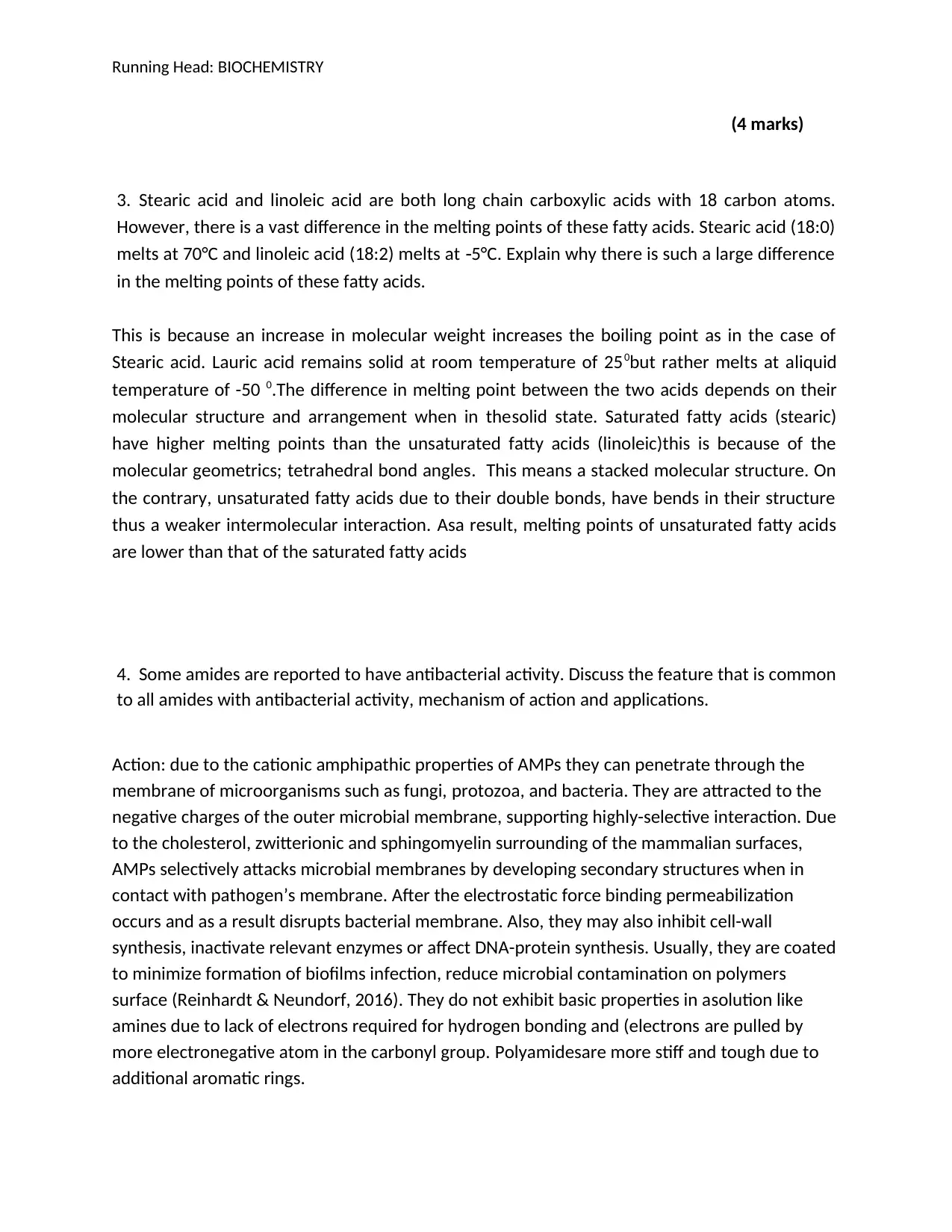
Running Head: BIOCHEMISTRY
(4 marks)
3. Stearic acid and linoleic acid are both long chain carboxylic acids with 18 carbon atoms.
However, there is a vast difference in the melting points of these fatty acids. Stearic acid (18:0)
melts at 70°C and linoleic acid (18:2) melts at 5°C. Explain why there is such a large difference‐
in the melting points of these fatty acids.
This is because an increase in molecular weight increases the boiling point as in the case of
Stearic acid. Lauric acid remains solid at room temperature of 250but rather melts at aliquid
temperature of -50 0.The difference in melting point between the two acids depends on their
molecular structure and arrangement when in thesolid state. Saturated fatty acids (stearic)
have higher melting points than the unsaturated fatty acids (linoleic)this is because of the
molecular geometrics; tetrahedral bond angles. This means a stacked molecular structure. On
the contrary, unsaturated fatty acids due to their double bonds, have bends in their structure
thus a weaker intermolecular interaction. Asa result, melting points of unsaturated fatty acids
are lower than that of the saturated fatty acids
4. Some amides are reported to have antibacterial activity. Discuss the feature that is common
to all amides with antibacterial activity, mechanism of action and applications.
Action: due to the cationic amphipathic properties of AMPs they can penetrate through the
membrane of microorganisms such as fungi, protozoa, and bacteria. They are attracted to the
negative charges of the outer microbial membrane, supporting highly-selective interaction. Due
to the cholesterol, zwitterionic and sphingomyelin surrounding of the mammalian surfaces,
AMPs selectively attacks microbial membranes by developing secondary structures when in
contact with pathogen’s membrane. After the electrostatic force binding permeabilization
occurs and as a result disrupts bacterial membrane. Also, they may also inhibit cell-wall
synthesis, inactivate relevant enzymes or affect DNA-protein synthesis. Usually, they are coated
to minimize formation of biofilms infection, reduce microbial contamination on polymers
surface (Reinhardt & Neundorf, 2016). They do not exhibit basic properties in asolution like
amines due to lack of electrons required for hydrogen bonding and (electrons are pulled by
more electronegative atom in the carbonyl group. Polyamidesare more stiff and tough due to
additional aromatic rings.
(4 marks)
3. Stearic acid and linoleic acid are both long chain carboxylic acids with 18 carbon atoms.
However, there is a vast difference in the melting points of these fatty acids. Stearic acid (18:0)
melts at 70°C and linoleic acid (18:2) melts at 5°C. Explain why there is such a large difference‐
in the melting points of these fatty acids.
This is because an increase in molecular weight increases the boiling point as in the case of
Stearic acid. Lauric acid remains solid at room temperature of 250but rather melts at aliquid
temperature of -50 0.The difference in melting point between the two acids depends on their
molecular structure and arrangement when in thesolid state. Saturated fatty acids (stearic)
have higher melting points than the unsaturated fatty acids (linoleic)this is because of the
molecular geometrics; tetrahedral bond angles. This means a stacked molecular structure. On
the contrary, unsaturated fatty acids due to their double bonds, have bends in their structure
thus a weaker intermolecular interaction. Asa result, melting points of unsaturated fatty acids
are lower than that of the saturated fatty acids
4. Some amides are reported to have antibacterial activity. Discuss the feature that is common
to all amides with antibacterial activity, mechanism of action and applications.
Action: due to the cationic amphipathic properties of AMPs they can penetrate through the
membrane of microorganisms such as fungi, protozoa, and bacteria. They are attracted to the
negative charges of the outer microbial membrane, supporting highly-selective interaction. Due
to the cholesterol, zwitterionic and sphingomyelin surrounding of the mammalian surfaces,
AMPs selectively attacks microbial membranes by developing secondary structures when in
contact with pathogen’s membrane. After the electrostatic force binding permeabilization
occurs and as a result disrupts bacterial membrane. Also, they may also inhibit cell-wall
synthesis, inactivate relevant enzymes or affect DNA-protein synthesis. Usually, they are coated
to minimize formation of biofilms infection, reduce microbial contamination on polymers
surface (Reinhardt & Neundorf, 2016). They do not exhibit basic properties in asolution like
amines due to lack of electrons required for hydrogen bonding and (electrons are pulled by
more electronegative atom in the carbonyl group. Polyamidesare more stiff and tough due to
additional aromatic rings.
⊘ This is a preview!⊘
Do you want full access?
Subscribe today to unlock all pages.

Trusted by 1+ million students worldwide
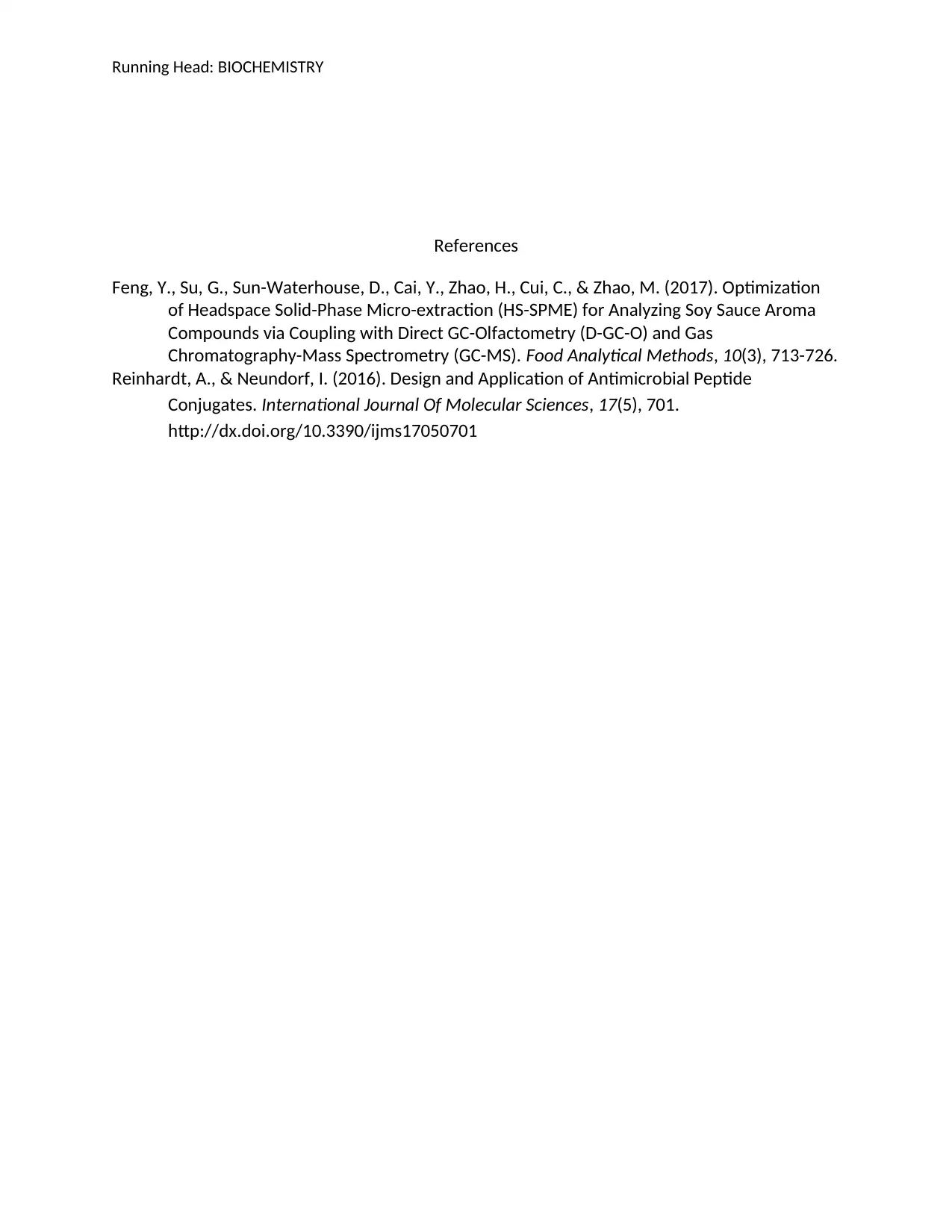
Running Head: BIOCHEMISTRY
References
Feng, Y., Su, G., Sun-Waterhouse, D., Cai, Y., Zhao, H., Cui, C., & Zhao, M. (2017). Optimization
of Headspace Solid-Phase Micro-extraction (HS-SPME) for Analyzing Soy Sauce Aroma
Compounds via Coupling with Direct GC-Olfactometry (D-GC-O) and Gas
Chromatography-Mass Spectrometry (GC-MS). Food Analytical Methods, 10(3), 713-726.
Reinhardt, A., & Neundorf, I. (2016). Design and Application of Antimicrobial Peptide
Conjugates. International Journal Of Molecular Sciences, 17(5), 701.
http://dx.doi.org/10.3390/ijms17050701
References
Feng, Y., Su, G., Sun-Waterhouse, D., Cai, Y., Zhao, H., Cui, C., & Zhao, M. (2017). Optimization
of Headspace Solid-Phase Micro-extraction (HS-SPME) for Analyzing Soy Sauce Aroma
Compounds via Coupling with Direct GC-Olfactometry (D-GC-O) and Gas
Chromatography-Mass Spectrometry (GC-MS). Food Analytical Methods, 10(3), 713-726.
Reinhardt, A., & Neundorf, I. (2016). Design and Application of Antimicrobial Peptide
Conjugates. International Journal Of Molecular Sciences, 17(5), 701.
http://dx.doi.org/10.3390/ijms17050701
Paraphrase This Document
Need a fresh take? Get an instant paraphrase of this document with our AI Paraphraser
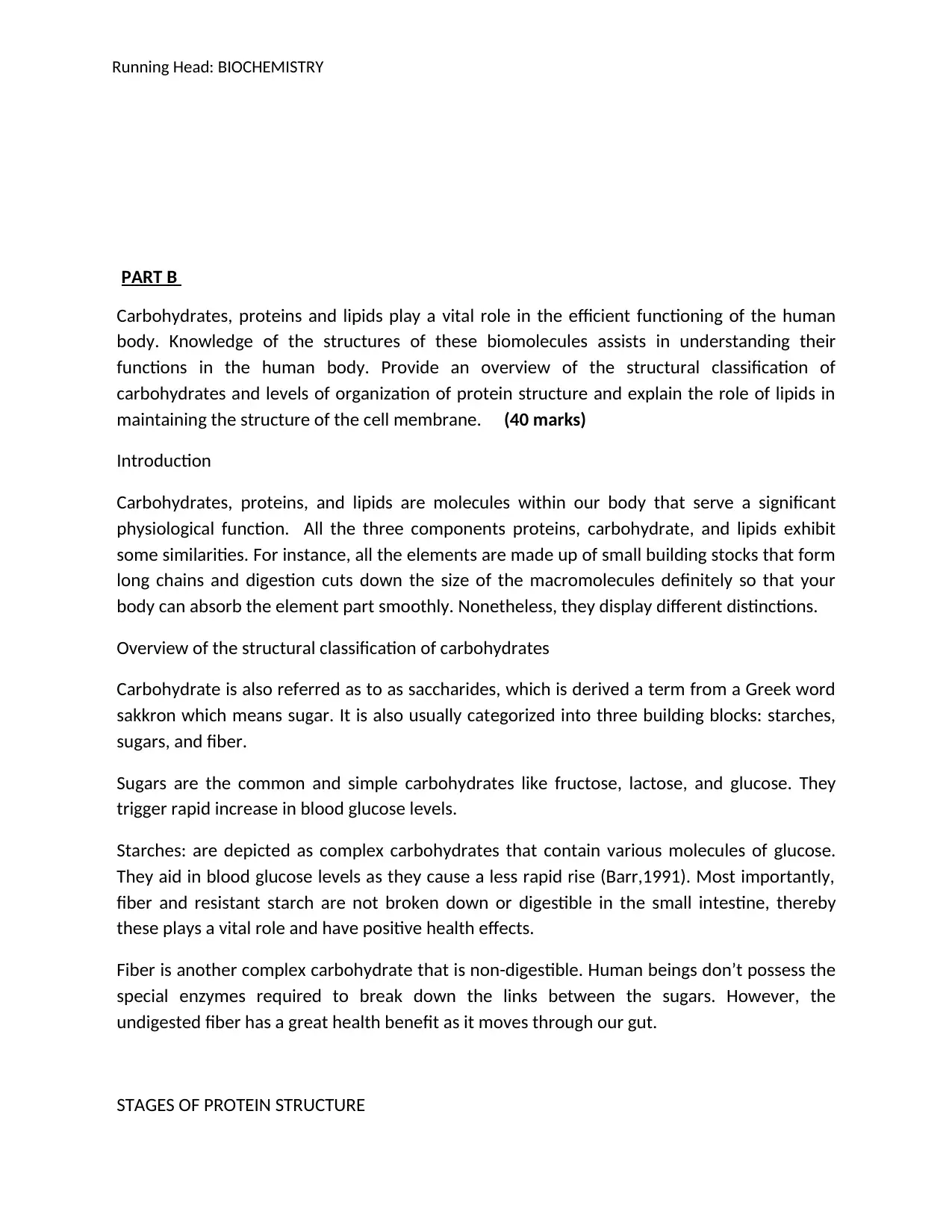
Running Head: BIOCHEMISTRY
PART B
Carbohydrates, proteins and lipids play a vital role in the efficient functioning of the human
body. Knowledge of the structures of these biomolecules assists in understanding their
functions in the human body. Provide an overview of the structural classification of
carbohydrates and levels of organization of protein structure and explain the role of lipids in
maintaining the structure of the cell membrane. (40 marks)
Introduction
Carbohydrates, proteins, and lipids are molecules within our body that serve a significant
physiological function. All the three components proteins, carbohydrate, and lipids exhibit
some similarities. For instance, all the elements are made up of small building stocks that form
long chains and digestion cuts down the size of the macromolecules definitely so that your
body can absorb the element part smoothly. Nonetheless, they display different distinctions.
Overview of the structural classification of carbohydrates
Carbohydrate is also referred as to as saccharides, which is derived a term from a Greek word
sakkron which means sugar. It is also usually categorized into three building blocks: starches,
sugars, and fiber.
Sugars are the common and simple carbohydrates like fructose, lactose, and glucose. They
trigger rapid increase in blood glucose levels.
Starches: are depicted as complex carbohydrates that contain various molecules of glucose.
They aid in blood glucose levels as they cause a less rapid rise (Barr,1991). Most importantly,
fiber and resistant starch are not broken down or digestible in the small intestine, thereby
these plays a vital role and have positive health effects.
Fiber is another complex carbohydrate that is non-digestible. Human beings don’t possess the
special enzymes required to break down the links between the sugars. However, the
undigested fiber has a great health benefit as it moves through our gut.
STAGES OF PROTEIN STRUCTURE
PART B
Carbohydrates, proteins and lipids play a vital role in the efficient functioning of the human
body. Knowledge of the structures of these biomolecules assists in understanding their
functions in the human body. Provide an overview of the structural classification of
carbohydrates and levels of organization of protein structure and explain the role of lipids in
maintaining the structure of the cell membrane. (40 marks)
Introduction
Carbohydrates, proteins, and lipids are molecules within our body that serve a significant
physiological function. All the three components proteins, carbohydrate, and lipids exhibit
some similarities. For instance, all the elements are made up of small building stocks that form
long chains and digestion cuts down the size of the macromolecules definitely so that your
body can absorb the element part smoothly. Nonetheless, they display different distinctions.
Overview of the structural classification of carbohydrates
Carbohydrate is also referred as to as saccharides, which is derived a term from a Greek word
sakkron which means sugar. It is also usually categorized into three building blocks: starches,
sugars, and fiber.
Sugars are the common and simple carbohydrates like fructose, lactose, and glucose. They
trigger rapid increase in blood glucose levels.
Starches: are depicted as complex carbohydrates that contain various molecules of glucose.
They aid in blood glucose levels as they cause a less rapid rise (Barr,1991). Most importantly,
fiber and resistant starch are not broken down or digestible in the small intestine, thereby
these plays a vital role and have positive health effects.
Fiber is another complex carbohydrate that is non-digestible. Human beings don’t possess the
special enzymes required to break down the links between the sugars. However, the
undigested fiber has a great health benefit as it moves through our gut.
STAGES OF PROTEIN STRUCTURE
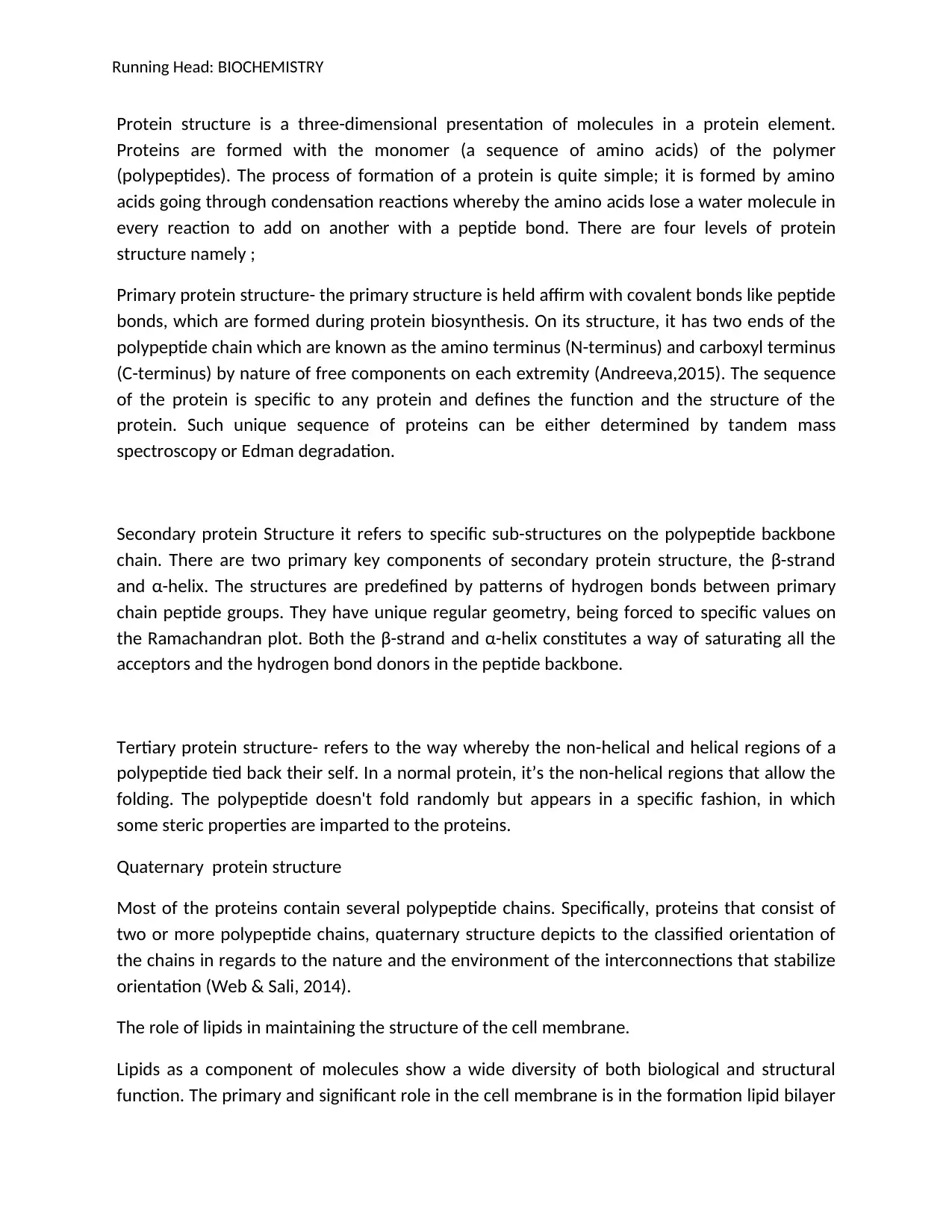
Running Head: BIOCHEMISTRY
Protein structure is a three-dimensional presentation of molecules in a protein element.
Proteins are formed with the monomer (a sequence of amino acids) of the polymer
(polypeptides). The process of formation of a protein is quite simple; it is formed by amino
acids going through condensation reactions whereby the amino acids lose a water molecule in
every reaction to add on another with a peptide bond. There are four levels of protein
structure namely ;
Primary protein structure- the primary structure is held affirm with covalent bonds like peptide
bonds, which are formed during protein biosynthesis. On its structure, it has two ends of the
polypeptide chain which are known as the amino terminus (N-terminus) and carboxyl terminus
(C-terminus) by nature of free components on each extremity (Andreeva,2015). The sequence
of the protein is specific to any protein and defines the function and the structure of the
protein. Such unique sequence of proteins can be either determined by tandem mass
spectroscopy or Edman degradation.
Secondary protein Structure it refers to specific sub-structures on the polypeptide backbone
chain. There are two primary key components of secondary protein structure, the β-strand
and α-helix. The structures are predefined by patterns of hydrogen bonds between primary
chain peptide groups. They have unique regular geometry, being forced to specific values on
the Ramachandran plot. Both the β-strand and α-helix constitutes a way of saturating all the
acceptors and the hydrogen bond donors in the peptide backbone.
Tertiary protein structure- refers to the way whereby the non-helical and helical regions of a
polypeptide tied back their self. In a normal protein, it’s the non-helical regions that allow the
folding. The polypeptide doesn't fold randomly but appears in a specific fashion, in which
some steric properties are imparted to the proteins.
Quaternary protein structure
Most of the proteins contain several polypeptide chains. Specifically, proteins that consist of
two or more polypeptide chains, quaternary structure depicts to the classified orientation of
the chains in regards to the nature and the environment of the interconnections that stabilize
orientation (Web & Sali, 2014).
The role of lipids in maintaining the structure of the cell membrane.
Lipids as a component of molecules show a wide diversity of both biological and structural
function. The primary and significant role in the cell membrane is in the formation lipid bilayer
Protein structure is a three-dimensional presentation of molecules in a protein element.
Proteins are formed with the monomer (a sequence of amino acids) of the polymer
(polypeptides). The process of formation of a protein is quite simple; it is formed by amino
acids going through condensation reactions whereby the amino acids lose a water molecule in
every reaction to add on another with a peptide bond. There are four levels of protein
structure namely ;
Primary protein structure- the primary structure is held affirm with covalent bonds like peptide
bonds, which are formed during protein biosynthesis. On its structure, it has two ends of the
polypeptide chain which are known as the amino terminus (N-terminus) and carboxyl terminus
(C-terminus) by nature of free components on each extremity (Andreeva,2015). The sequence
of the protein is specific to any protein and defines the function and the structure of the
protein. Such unique sequence of proteins can be either determined by tandem mass
spectroscopy or Edman degradation.
Secondary protein Structure it refers to specific sub-structures on the polypeptide backbone
chain. There are two primary key components of secondary protein structure, the β-strand
and α-helix. The structures are predefined by patterns of hydrogen bonds between primary
chain peptide groups. They have unique regular geometry, being forced to specific values on
the Ramachandran plot. Both the β-strand and α-helix constitutes a way of saturating all the
acceptors and the hydrogen bond donors in the peptide backbone.
Tertiary protein structure- refers to the way whereby the non-helical and helical regions of a
polypeptide tied back their self. In a normal protein, it’s the non-helical regions that allow the
folding. The polypeptide doesn't fold randomly but appears in a specific fashion, in which
some steric properties are imparted to the proteins.
Quaternary protein structure
Most of the proteins contain several polypeptide chains. Specifically, proteins that consist of
two or more polypeptide chains, quaternary structure depicts to the classified orientation of
the chains in regards to the nature and the environment of the interconnections that stabilize
orientation (Web & Sali, 2014).
The role of lipids in maintaining the structure of the cell membrane.
Lipids as a component of molecules show a wide diversity of both biological and structural
function. The primary and significant role in the cell membrane is in the formation lipid bilayer
⊘ This is a preview!⊘
Do you want full access?
Subscribe today to unlock all pages.

Trusted by 1+ million students worldwide
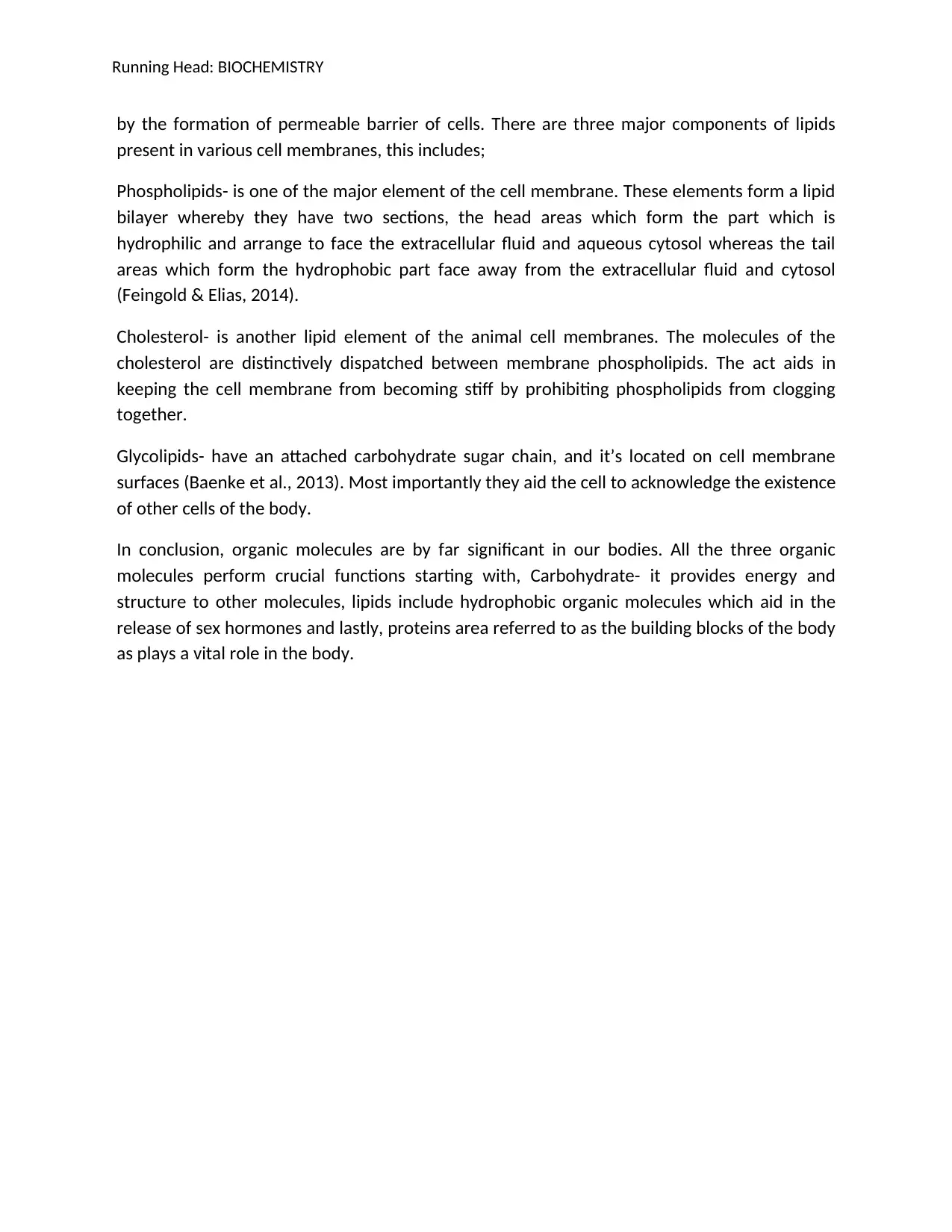
Running Head: BIOCHEMISTRY
by the formation of permeable barrier of cells. There are three major components of lipids
present in various cell membranes, this includes;
Phospholipids- is one of the major element of the cell membrane. These elements form a lipid
bilayer whereby they have two sections, the head areas which form the part which is
hydrophilic and arrange to face the extracellular fluid and aqueous cytosol whereas the tail
areas which form the hydrophobic part face away from the extracellular fluid and cytosol
(Feingold & Elias, 2014).
Cholesterol- is another lipid element of the animal cell membranes. The molecules of the
cholesterol are distinctively dispatched between membrane phospholipids. The act aids in
keeping the cell membrane from becoming stiff by prohibiting phospholipids from clogging
together.
Glycolipids- have an attached carbohydrate sugar chain, and it’s located on cell membrane
surfaces (Baenke et al., 2013). Most importantly they aid the cell to acknowledge the existence
of other cells of the body.
In conclusion, organic molecules are by far significant in our bodies. All the three organic
molecules perform crucial functions starting with, Carbohydrate- it provides energy and
structure to other molecules, lipids include hydrophobic organic molecules which aid in the
release of sex hormones and lastly, proteins area referred to as the building blocks of the body
as plays a vital role in the body.
by the formation of permeable barrier of cells. There are three major components of lipids
present in various cell membranes, this includes;
Phospholipids- is one of the major element of the cell membrane. These elements form a lipid
bilayer whereby they have two sections, the head areas which form the part which is
hydrophilic and arrange to face the extracellular fluid and aqueous cytosol whereas the tail
areas which form the hydrophobic part face away from the extracellular fluid and cytosol
(Feingold & Elias, 2014).
Cholesterol- is another lipid element of the animal cell membranes. The molecules of the
cholesterol are distinctively dispatched between membrane phospholipids. The act aids in
keeping the cell membrane from becoming stiff by prohibiting phospholipids from clogging
together.
Glycolipids- have an attached carbohydrate sugar chain, and it’s located on cell membrane
surfaces (Baenke et al., 2013). Most importantly they aid the cell to acknowledge the existence
of other cells of the body.
In conclusion, organic molecules are by far significant in our bodies. All the three organic
molecules perform crucial functions starting with, Carbohydrate- it provides energy and
structure to other molecules, lipids include hydrophobic organic molecules which aid in the
release of sex hormones and lastly, proteins area referred to as the building blocks of the body
as plays a vital role in the body.
Paraphrase This Document
Need a fresh take? Get an instant paraphrase of this document with our AI Paraphraser
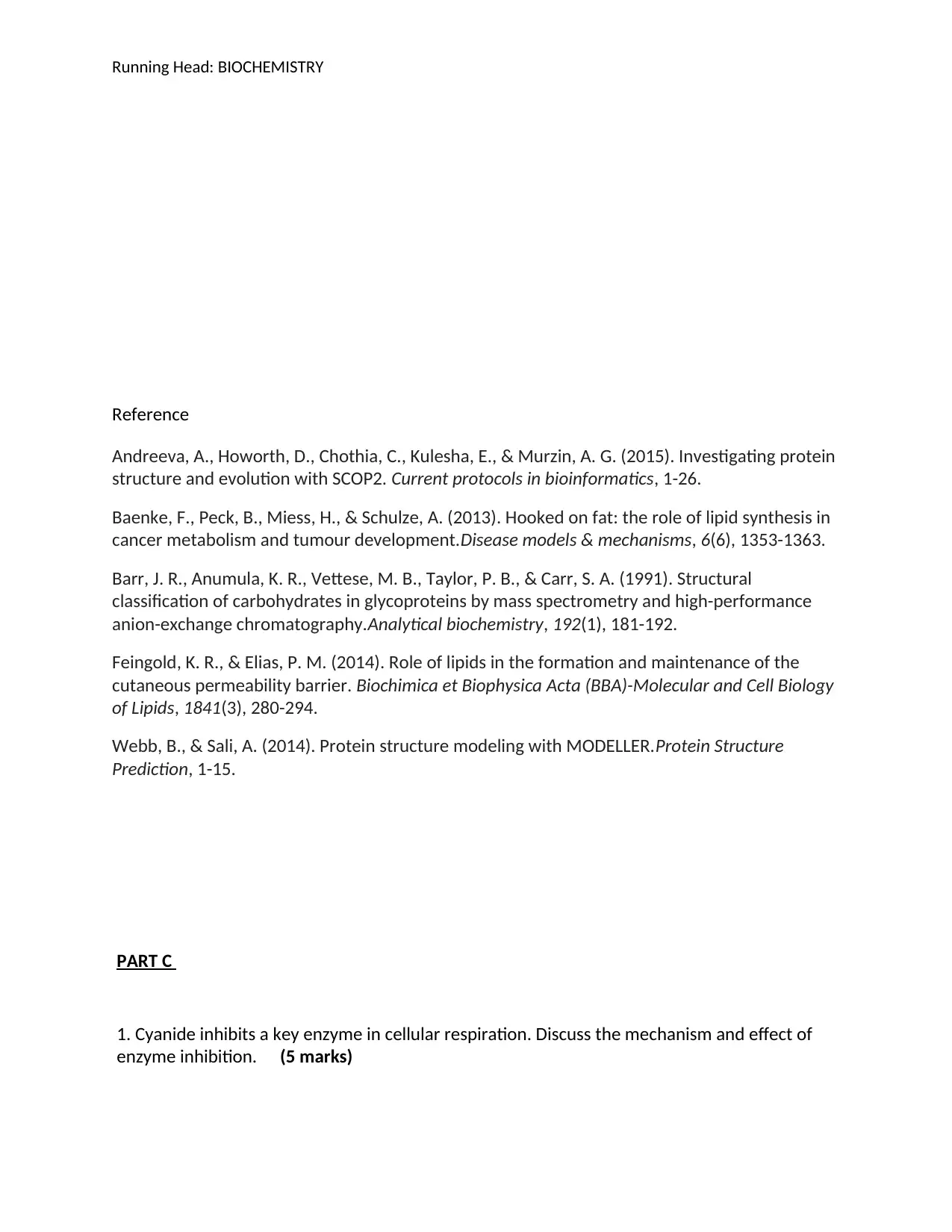
Running Head: BIOCHEMISTRY
Reference
Andreeva, A., Howorth, D., Chothia, C., Kulesha, E., & Murzin, A. G. (2015). Investigating protein
structure and evolution with SCOP2. Current protocols in bioinformatics, 1-26.
Baenke, F., Peck, B., Miess, H., & Schulze, A. (2013). Hooked on fat: the role of lipid synthesis in
cancer metabolism and tumour development.Disease models & mechanisms, 6(6), 1353-1363.
Barr, J. R., Anumula, K. R., Vettese, M. B., Taylor, P. B., & Carr, S. A. (1991). Structural
classification of carbohydrates in glycoproteins by mass spectrometry and high-performance
anion-exchange chromatography.Analytical biochemistry, 192(1), 181-192.
Feingold, K. R., & Elias, P. M. (2014). Role of lipids in the formation and maintenance of the
cutaneous permeability barrier. Biochimica et Biophysica Acta (BBA)-Molecular and Cell Biology
of Lipids, 1841(3), 280-294.
Webb, B., & Sali, A. (2014). Protein structure modeling with MODELLER.Protein Structure
Prediction, 1-15.
PART C
1. Cyanide inhibits a key enzyme in cellular respiration. Discuss the mechanism and effect of
enzyme inhibition. (5 marks)
Reference
Andreeva, A., Howorth, D., Chothia, C., Kulesha, E., & Murzin, A. G. (2015). Investigating protein
structure and evolution with SCOP2. Current protocols in bioinformatics, 1-26.
Baenke, F., Peck, B., Miess, H., & Schulze, A. (2013). Hooked on fat: the role of lipid synthesis in
cancer metabolism and tumour development.Disease models & mechanisms, 6(6), 1353-1363.
Barr, J. R., Anumula, K. R., Vettese, M. B., Taylor, P. B., & Carr, S. A. (1991). Structural
classification of carbohydrates in glycoproteins by mass spectrometry and high-performance
anion-exchange chromatography.Analytical biochemistry, 192(1), 181-192.
Feingold, K. R., & Elias, P. M. (2014). Role of lipids in the formation and maintenance of the
cutaneous permeability barrier. Biochimica et Biophysica Acta (BBA)-Molecular and Cell Biology
of Lipids, 1841(3), 280-294.
Webb, B., & Sali, A. (2014). Protein structure modeling with MODELLER.Protein Structure
Prediction, 1-15.
PART C
1. Cyanide inhibits a key enzyme in cellular respiration. Discuss the mechanism and effect of
enzyme inhibition. (5 marks)
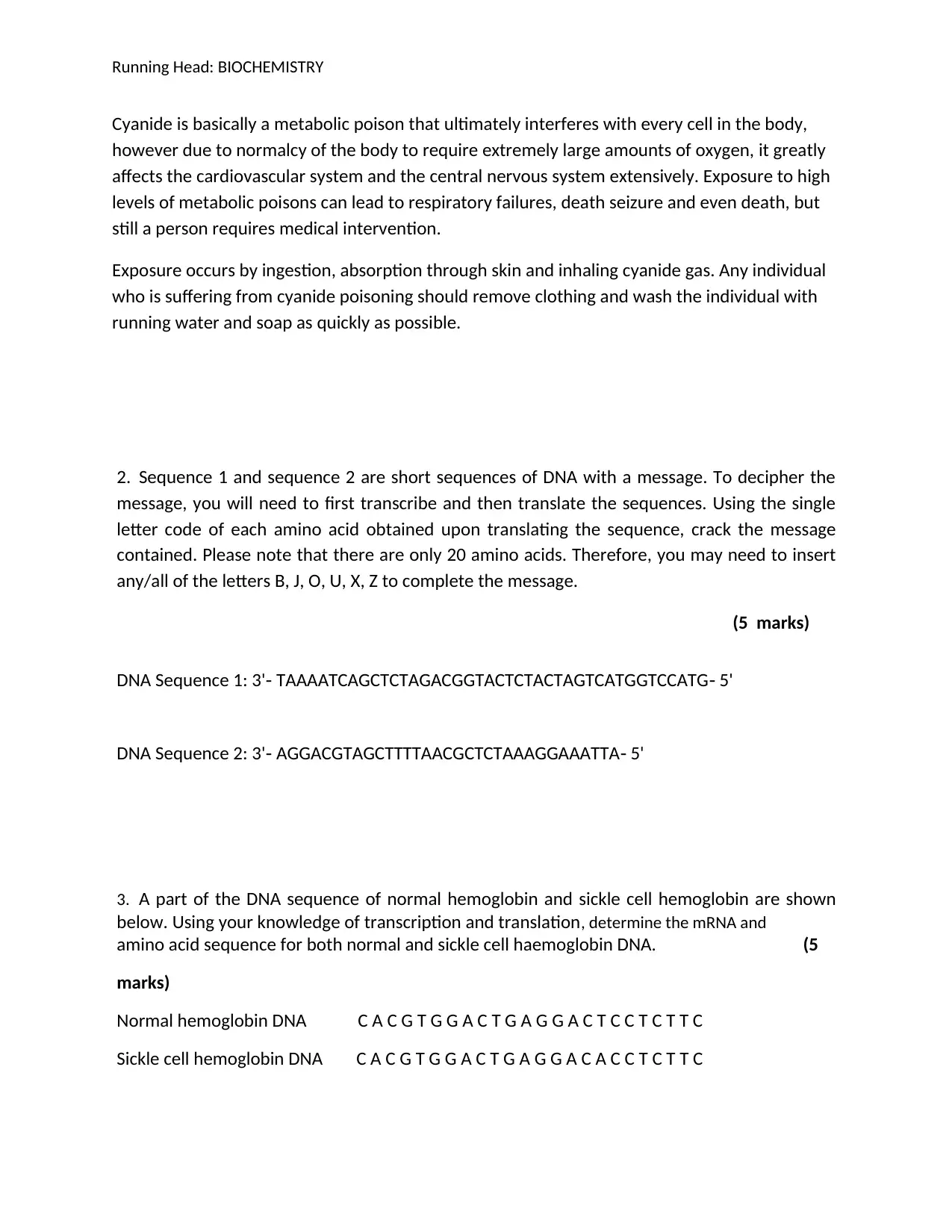
Running Head: BIOCHEMISTRY
Cyanide is basically a metabolic poison that ultimately interferes with every cell in the body,
however due to normalcy of the body to require extremely large amounts of oxygen, it greatly
affects the cardiovascular system and the central nervous system extensively. Exposure to high
levels of metabolic poisons can lead to respiratory failures, death seizure and even death, but
still a person requires medical intervention.
Exposure occurs by ingestion, absorption through skin and inhaling cyanide gas. Any individual
who is suffering from cyanide poisoning should remove clothing and wash the individual with
running water and soap as quickly as possible.
2. Sequence 1 and sequence 2 are short sequences of DNA with a message. To decipher the
message, you will need to first transcribe and then translate the sequences. Using the single
letter code of each amino acid obtained upon translating the sequence, crack the message
contained. Please note that there are only 20 amino acids. Therefore, you may need to insert
any/all of the letters B, J, O, U, X, Z to complete the message.
(5 marks)
DNA Sequence 1: 3' TAAAATCAGCTCTAGACGGTACTCTACTAGTCATGGTCCATG 5'‐ ‐
DNA Sequence 2: 3' AGGACGTAGCTTTTAACGCTCTAAAGGAAATTA 5'‐ ‐
3. A part of the DNA sequence of normal hemoglobin and sickle cell hemoglobin are shown
below. Using your knowledge of transcription and translation, determine the mRNA and
amino acid sequence for both normal and sickle cell haemoglobin DNA. (5
marks)
Normal hemoglobin DNA C A C G T G G A C T G A G G A C T C C T C T T C
Sickle cell hemoglobin DNA C A C G T G G A C T G A G G A C A C C T C T T C
Cyanide is basically a metabolic poison that ultimately interferes with every cell in the body,
however due to normalcy of the body to require extremely large amounts of oxygen, it greatly
affects the cardiovascular system and the central nervous system extensively. Exposure to high
levels of metabolic poisons can lead to respiratory failures, death seizure and even death, but
still a person requires medical intervention.
Exposure occurs by ingestion, absorption through skin and inhaling cyanide gas. Any individual
who is suffering from cyanide poisoning should remove clothing and wash the individual with
running water and soap as quickly as possible.
2. Sequence 1 and sequence 2 are short sequences of DNA with a message. To decipher the
message, you will need to first transcribe and then translate the sequences. Using the single
letter code of each amino acid obtained upon translating the sequence, crack the message
contained. Please note that there are only 20 amino acids. Therefore, you may need to insert
any/all of the letters B, J, O, U, X, Z to complete the message.
(5 marks)
DNA Sequence 1: 3' TAAAATCAGCTCTAGACGGTACTCTACTAGTCATGGTCCATG 5'‐ ‐
DNA Sequence 2: 3' AGGACGTAGCTTTTAACGCTCTAAAGGAAATTA 5'‐ ‐
3. A part of the DNA sequence of normal hemoglobin and sickle cell hemoglobin are shown
below. Using your knowledge of transcription and translation, determine the mRNA and
amino acid sequence for both normal and sickle cell haemoglobin DNA. (5
marks)
Normal hemoglobin DNA C A C G T G G A C T G A G G A C T C C T C T T C
Sickle cell hemoglobin DNA C A C G T G G A C T G A G G A C A C C T C T T C
⊘ This is a preview!⊘
Do you want full access?
Subscribe today to unlock all pages.

Trusted by 1+ million students worldwide
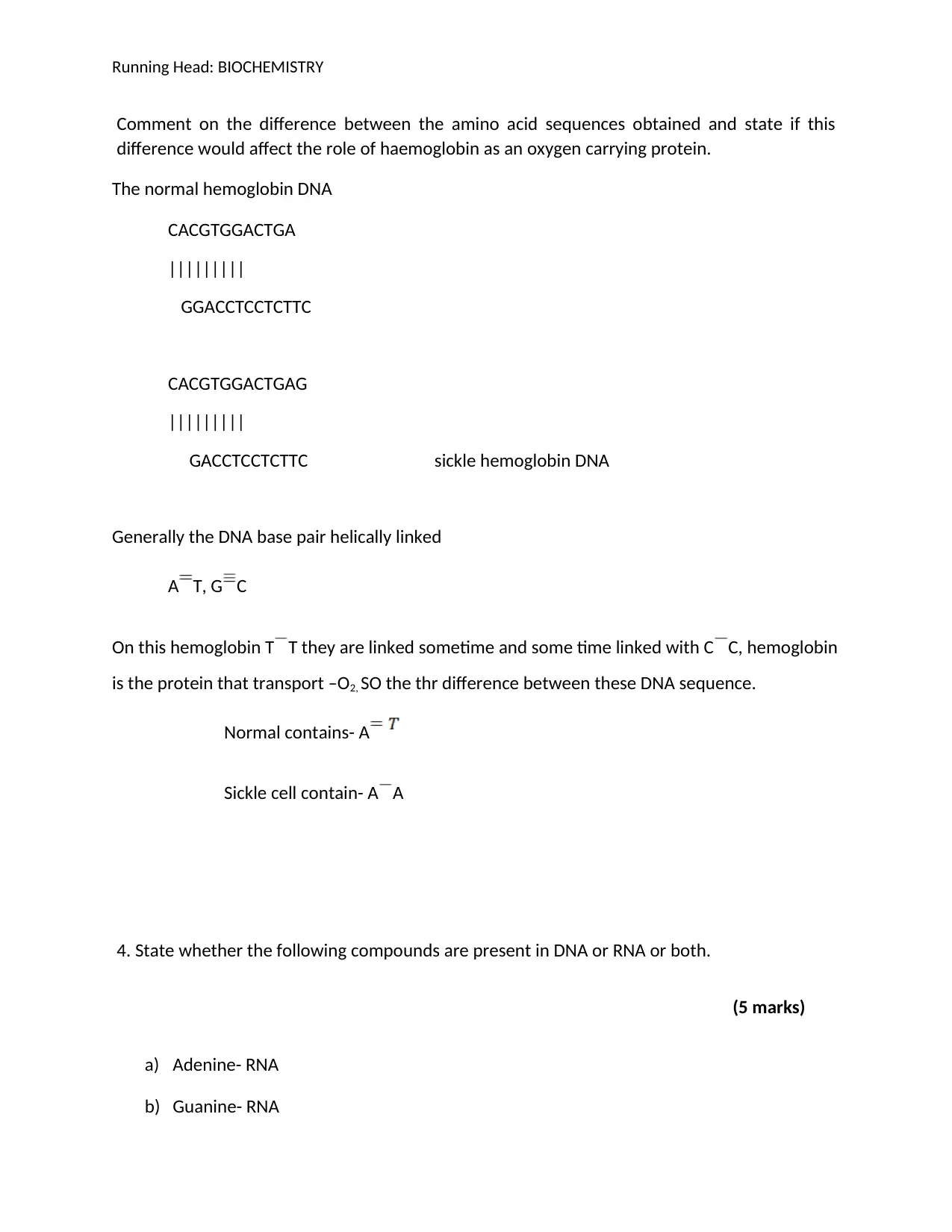
Running Head: BIOCHEMISTRY
Comment on the difference between the amino acid sequences obtained and state if this
difference would affect the role of haemoglobin as an oxygen carrying protein.
The normal hemoglobin DNA
CACGTGGACTGA
|||||||||
GGACCTCCTCTTC
CACGTGGACTGAG
|||||||||
GACCTCCTCTTC sickle hemoglobin DNA
Generally the DNA base pair helically linked
A T, G C
On this hemoglobin T T they are linked sometime and some time linked with C C, hemoglobin
is the protein that transport –O2, SO the thr difference between these DNA sequence.
Normal contains- A
Sickle cell contain- A A
4. State whether the following compounds are present in DNA or RNA or both.
(5 marks)
a) Adenine- RNA
b) Guanine- RNA
Comment on the difference between the amino acid sequences obtained and state if this
difference would affect the role of haemoglobin as an oxygen carrying protein.
The normal hemoglobin DNA
CACGTGGACTGA
|||||||||
GGACCTCCTCTTC
CACGTGGACTGAG
|||||||||
GACCTCCTCTTC sickle hemoglobin DNA
Generally the DNA base pair helically linked
A T, G C
On this hemoglobin T T they are linked sometime and some time linked with C C, hemoglobin
is the protein that transport –O2, SO the thr difference between these DNA sequence.
Normal contains- A
Sickle cell contain- A A
4. State whether the following compounds are present in DNA or RNA or both.
(5 marks)
a) Adenine- RNA
b) Guanine- RNA
Paraphrase This Document
Need a fresh take? Get an instant paraphrase of this document with our AI Paraphraser
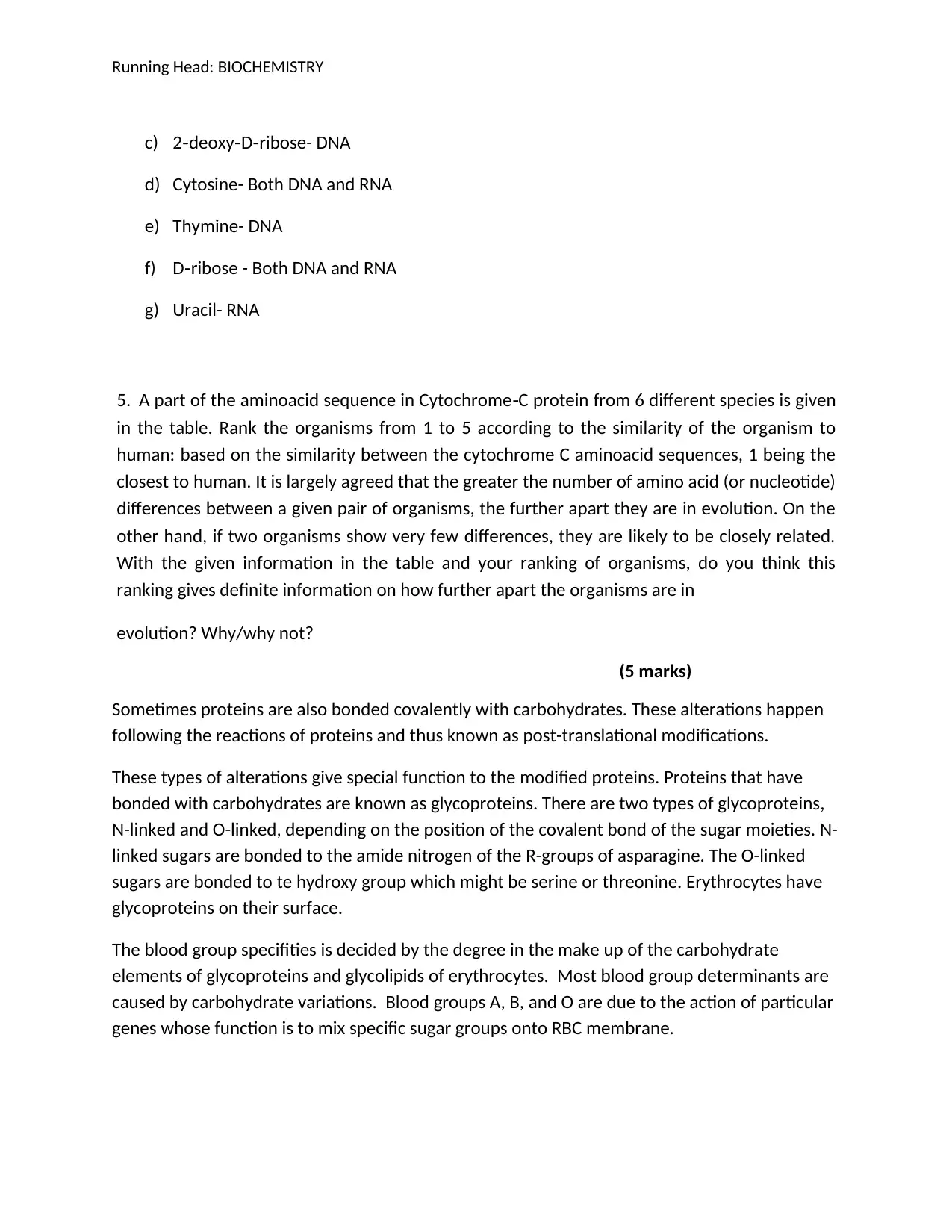
Running Head: BIOCHEMISTRY
c) 2 deoxy D ribose- DNA‐ ‐ ‐
d) Cytosine- Both DNA and RNA
e) Thymine- DNA
f) D ribose - Both DNA and RNA‐
g) Uracil- RNA
5. A part of the aminoacid sequence in Cytochrome C protein from 6 different species is given‐
in the table. Rank the organisms from 1 to 5 according to the similarity of the organism to
human: based on the similarity between the cytochrome C aminoacid sequences, 1 being the
closest to human. It is largely agreed that the greater the number of amino acid (or nucleotide)
differences between a given pair of organisms, the further apart they are in evolution. On the
other hand, if two organisms show very few differences, they are likely to be closely related.
With the given information in the table and your ranking of organisms, do you think this
ranking gives definite information on how further apart the organisms are in
evolution? Why/why not?
(5 marks)
Sometimes proteins are also bonded covalently with carbohydrates. These alterations happen
following the reactions of proteins and thus known as post-translational modifications.
These types of alterations give special function to the modified proteins. Proteins that have
bonded with carbohydrates are known as glycoproteins. There are two types of glycoproteins,
N-linked and O-linked, depending on the position of the covalent bond of the sugar moieties. N-
linked sugars are bonded to the amide nitrogen of the R-groups of asparagine. The O-linked
sugars are bonded to te hydroxy group which might be serine or threonine. Erythrocytes have
glycoproteins on their surface.
The blood group specifities is decided by the degree in the make up of the carbohydrate
elements of glycoproteins and glycolipids of erythrocytes. Most blood group determinants are
caused by carbohydrate variations. Blood groups A, B, and O are due to the action of particular
genes whose function is to mix specific sugar groups onto RBC membrane.
c) 2 deoxy D ribose- DNA‐ ‐ ‐
d) Cytosine- Both DNA and RNA
e) Thymine- DNA
f) D ribose - Both DNA and RNA‐
g) Uracil- RNA
5. A part of the aminoacid sequence in Cytochrome C protein from 6 different species is given‐
in the table. Rank the organisms from 1 to 5 according to the similarity of the organism to
human: based on the similarity between the cytochrome C aminoacid sequences, 1 being the
closest to human. It is largely agreed that the greater the number of amino acid (or nucleotide)
differences between a given pair of organisms, the further apart they are in evolution. On the
other hand, if two organisms show very few differences, they are likely to be closely related.
With the given information in the table and your ranking of organisms, do you think this
ranking gives definite information on how further apart the organisms are in
evolution? Why/why not?
(5 marks)
Sometimes proteins are also bonded covalently with carbohydrates. These alterations happen
following the reactions of proteins and thus known as post-translational modifications.
These types of alterations give special function to the modified proteins. Proteins that have
bonded with carbohydrates are known as glycoproteins. There are two types of glycoproteins,
N-linked and O-linked, depending on the position of the covalent bond of the sugar moieties. N-
linked sugars are bonded to the amide nitrogen of the R-groups of asparagine. The O-linked
sugars are bonded to te hydroxy group which might be serine or threonine. Erythrocytes have
glycoproteins on their surface.
The blood group specifities is decided by the degree in the make up of the carbohydrate
elements of glycoproteins and glycolipids of erythrocytes. Most blood group determinants are
caused by carbohydrate variations. Blood groups A, B, and O are due to the action of particular
genes whose function is to mix specific sugar groups onto RBC membrane.
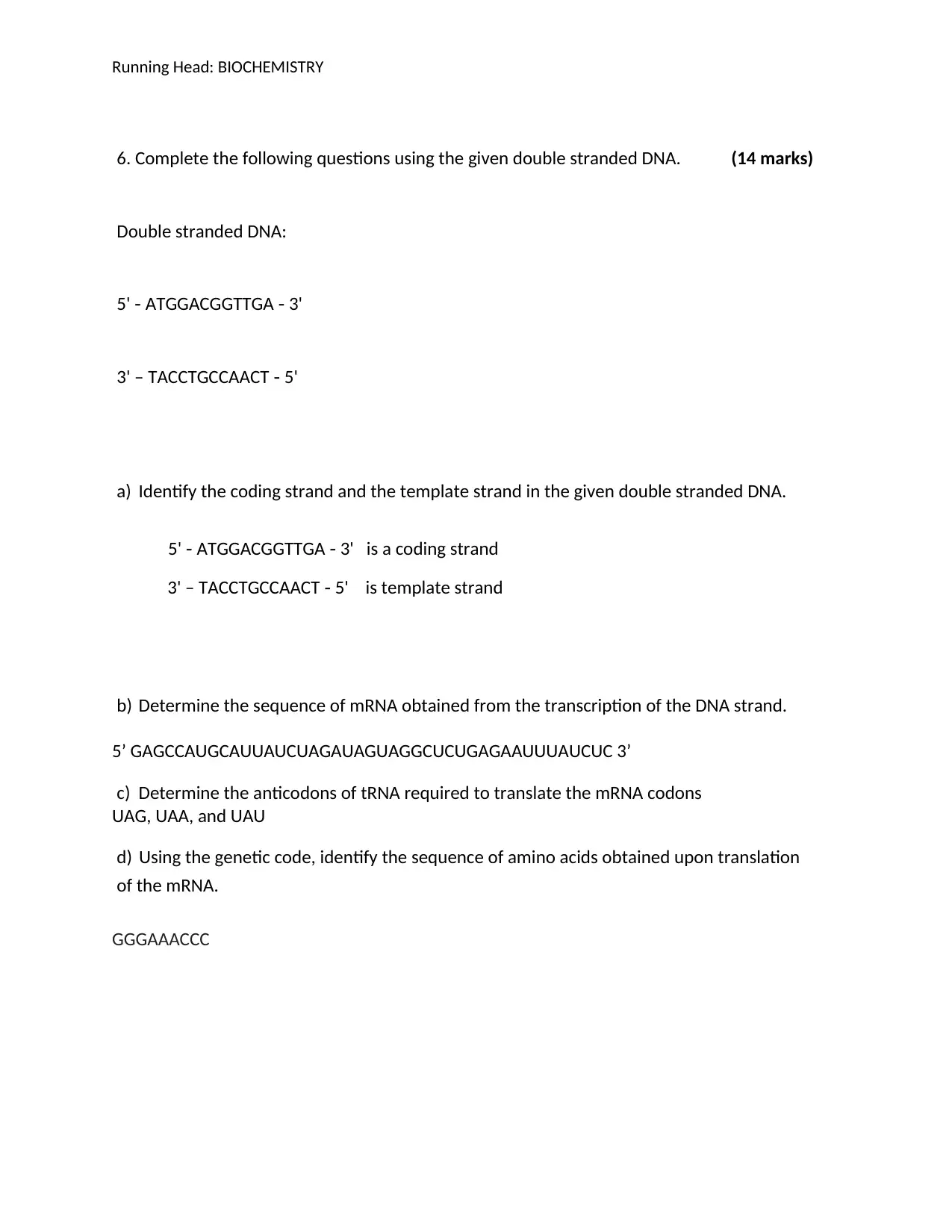
Running Head: BIOCHEMISTRY
6. Complete the following questions using the given double stranded DNA. (14 marks)
Double stranded DNA:
5' ATGGACGGTTGA 3'‐ ‐
3' – TACCTGCCAACT 5'‐
a) Identify the coding strand and the template strand in the given double stranded DNA.
5' ATGGACGGTTGA 3' is a coding strand‐ ‐
3' – TACCTGCCAACT 5' is template strand‐
b) Determine the sequence of mRNA obtained from the transcription of the DNA strand.
5’ GAGCCAUGCAUUAUCUAGAUAGUAGGCUCUGAGAAUUUAUCUC 3’
c) Determine the anticodons of tRNA required to translate the mRNA codons
UAG, UAA, and UAU
d) Using the genetic code, identify the sequence of amino acids obtained upon translation
of the mRNA.
GGGAAACCC
6. Complete the following questions using the given double stranded DNA. (14 marks)
Double stranded DNA:
5' ATGGACGGTTGA 3'‐ ‐
3' – TACCTGCCAACT 5'‐
a) Identify the coding strand and the template strand in the given double stranded DNA.
5' ATGGACGGTTGA 3' is a coding strand‐ ‐
3' – TACCTGCCAACT 5' is template strand‐
b) Determine the sequence of mRNA obtained from the transcription of the DNA strand.
5’ GAGCCAUGCAUUAUCUAGAUAGUAGGCUCUGAGAAUUUAUCUC 3’
c) Determine the anticodons of tRNA required to translate the mRNA codons
UAG, UAA, and UAU
d) Using the genetic code, identify the sequence of amino acids obtained upon translation
of the mRNA.
GGGAAACCC
⊘ This is a preview!⊘
Do you want full access?
Subscribe today to unlock all pages.

Trusted by 1+ million students worldwide
1 out of 12
Related Documents
Your All-in-One AI-Powered Toolkit for Academic Success.
+13062052269
info@desklib.com
Available 24*7 on WhatsApp / Email
![[object Object]](/_next/static/media/star-bottom.7253800d.svg)
Unlock your academic potential
Copyright © 2020–2025 A2Z Services. All Rights Reserved. Developed and managed by ZUCOL.





